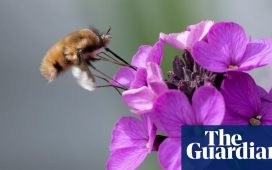Invasive species such as the grey squirrel, Japanese knotweed and the European rabbit have cost the UK economy at least £5bn since the mid 1970s, according to research.
Ecosystem-altering plants and animals that wipe out native wildlife, often introduced by humans, have cost the country at least £122m a year on average since 1976, causing structural damage to buildings, clogging waterways and ruining crops.
Researchers said the figure is likely to be a significant underestimate due to information gaps on the economic impact of dozens of species, and warned that the financial burden from invasive species is rising in the UK.
The European rabbit, Japanese knotweed and the rock pigeon account for most of the cost, estimated at between £5.4bn and £13.7bn over the past 45 years, among the highest in Europe. Peer-reviewed information on financial cost exists for only 42 of the 520 invasive species in the UK identified in the study, with nothing available for high-profile plants and animals with significant ecological impacts such as the Asian hornet and the fungus that causes ash dieback.

The research synthesised available data on the cost of invasive species in the UK to make the assessment and the findings were published on Thursday in the journal NeoBiota, concluding that greater investment in invasive species research and biosecurity management is urgently needed.
Ross Cuthbert, a research associate at Queen’s University in Belfast who led the study, said that while the ecological impact of invasive species was well understood, their economic impact was less so. The study involved an international group of researchers that have built the first global database of invasion costs – InvaCost – led by a team at Paris-Saclay University.
“We’re seeing more and more of these species arrive in the UK and invasion costs are likely to continue rising in the future without sufficient management. The species that are causing problems now were often introduced several centuries ago and the best way to stop future costs is to prevent invasive species from arriving,” Cuthbert said. “There’s only a few examples of species which we’ve successfully eradicated from the UK.”
Non-native animals and plants that disrupt the balance of ecosystems and wipe out other organisms, resulting in large populations of invasive species, are a leading driver of biodiversity loss around the world, according to the UN. Examples of widely distributed invasive species in the UK include the signal crayfish, the muntjac deer and the Chinese mitten crab. Less widely spread examples are the Asian hornet and the red swamp crayfish.

“There needs to be better recording of the impact of invasive species. We can only include information that’s been published in scientific journals or government reports, but this isn’t available for a lot of species,” Cuthbert said. “It could just be sitting on people’s desks in government departments.”
The UN’s scientific body on biodiversity, IPBES, is working on a major assessment of invasive and alien species around the world, which will be published in 2023.
Prof Helen Roy, an ecologist at the UK Centre for Ecology and Hydrology and one of the co-chairs overseeing the IPBES assessment, said: “Evaluating the economic costs of invasive non-native species is important and can inform prioritisation, particularly when considering actions that can prevent arrival of the species most damaging to people and our natural world. Everyone can make a difference by following simple biosecurity approaches.”
The GB non-native species secretariat publishes guidance on how to stop the spread of invasive species, including checking and cleaning equipment such as fishing nets for organic matter after they have been used.
Find more age of extinction coverage here, and follow biodiversity reporters Phoebe Weston and Patrick Greenfield on Twitter for all the latest news and features







